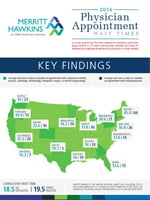
How Long Do Patients Wait to See a Doctor? It Depends…
 The doctor may be in, but how long it takes for patients to see him or her varies considerably depending on where they live. Patients in Dallas are likely to get timely appointments, for instance, while Boston-area patients will need more patience for the long wait.
The doctor may be in, but how long it takes for patients to see him or her varies considerably depending on where they live. Patients in Dallas are likely to get timely appointments, for instance, while Boston-area patients will need more patience for the long wait.
In a new survey of 1,399 medical offices representing 15 large metropolitan areas, Merritt Hawkins, the leading physician search and consulting firm and a company of AMN Healthcare, tracked the average time needed to schedule a doctor appointment. The survey reports average doctor appointment wait times in five different medical specialties: cardiology, dermatology, obstetrics/gynecology, orthopedic surgery and family practice.
Boston is experiencing the longest average doctor appointment wait times among the 15 markets examined: 72 days to see a dermatologist, 66 days to see a family physician, 46 days to see an ob/gyn, 27 days to see a cardiologist, and 16 days to see an orthopedic surgeon. On average, it takes over 45 days to schedule a doctor appointment in the Boston area, the survey indicates. These findings are consistent with two previous Merritt Hawkins surveys in 2004 and 2009, when Boston also averaged the longest wait times among the 15 cities.
Other average physician appointment wait times tracked by the survey include 28 days to see a cardiologist in Denver, 49 days to see a dermatologist in Philadelphia, 35 days to see an ob/gyn in Portland, 18 days to see an orthopedic surgeon in San Diego, and 26 days to see a family physician in New York.
Doctor appointment wait times tracked in the survey varied from as little as one day to over eight months, with an overall average in all metro areas and all specialties of about 19 days.
"Finding a physician who can see you today, or three weeks from today, can be a challenge, even in urban areas where there is a high ratio of physicians per population," said Mark Smith, president of Merritt Hawkins. "The demand for doctors is simply outstripping the supply."
The survey also tracks how many physician practices accept Medicaid as a form of payment in the 15 metro markets. Boston has the highest rate of Medicaid acceptance tracked in the survey at 73%, while Dallas has the lowest at 23% (Dallas also has the shortest average wait times among the cities tracked). The overall average rate of Medicaid acceptance for all five specialties in all 15 markets came to 45.7%.
Many physicians are not accepting Medicaid because it often pays less than what it costs physicians to provide care, according to Smith. Medicaid patients, and patients with private insurance, often seek "convenient care" in hospital emergency departments when they cannot access office-based physicians in a timely manner. The problem of physician access could become more pronounced as millions of previously uninsured patients obtain coverage through the Affordable Care Act.
"Having health insurance does not always ensure access to a physician," Smith said. "More physicians will need to be trained, and access to other types of providers expanded, to ensure that health care delayed does not become health care denied."
For more information:
View the infographic of key findings from the Merritt Hawkins 2014 Survey of Physician Appointment Wait Times and Medicaid and Medicare Acceptance Rates, or find more information and request the full survey at www.merritthawkins.com.
© 2014. AMN Healthcare, Inc. All Rights Reserved.


